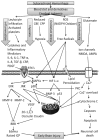Subarachnoid hemorrhage: is it time for a new direction?
- PMID: 19064787
- PMCID: PMC2743545
- DOI: 10.1161/STROKEAHA.108.533315
Subarachnoid hemorrhage: is it time for a new direction?
Abstract
Background and purpose: Despite recent advances in the treatment of patients after subarachnoid hemorrhage, morbidity and mortality rates have failed to improve significantly. Although this was often blamed on vasospasm, is it time to consider alternative etiologies? Summary of Review- Early brain injury (EBI) is a recently described term that describes the immediate injury to the brain after subarachnoid hemorrhage. A number of pathways have been recognized as having a role in the etiology of EBI. This review provides a brief synopsis of EBI and its implications for the future.
Conclusions: EBI may be responsible for the detrimental effects seen in patients after subarachnoid hemorrhage. Additional studies are needed to determine the pathophysiology of EBI and to explore potential therapeutic options.
Figures
References
-
- Sobey CG, Faraci FM. Subarachnoid haemorrhage: what happens to the cerebral arteries? Clin Exp Pharmacol Physiol. 1998;25:867–876. - PubMed
-
- Schievink WI. Intracranial aneurysms. N Engl J Med. 1997;336:28–40. - PubMed
-
- Vajkoczy P, Meyer B, Weidauer S, Raabe A, Thome C, Ringel F, Breu V, Schmiedek P. Clazosentan (AXV-034343), a selective endothelin A receptor antagonist, in the prevention of cerebral vasospasm following severe aneurysmal subarachnoid hemorrhage: results of a randomized, double-blind, placebo-controlled, multicenter phase IIa study. J Neurosurg. 2005;103:9–17. - PubMed
Publication types
MeSH terms
Grants and funding
LinkOut - more resources
Full Text Sources


